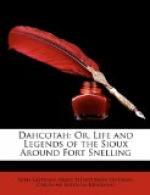In fact, dreams, spells and superstitious fears, constitute a large part of the belief of the Dahcotahs. But of all their superstitious notions the most curious is the one which occasions the dance called Ho-saw-kah-u-tap-pe, or Fish dance, where the fish is eaten raw.
Some days since, an Indian who lives at Shah-co-pee’s village dreamed of seeing a cormorant, a bird which feeds on fish. He was very much alarmed, and directed his friend to go out and catch a fish, and to bring the first one he caught to him.
The Indian did so, and the fish, which was a large pike, was painted with blue clay. Preparations were immediately made to celebrate the Fish dance, in order to ward off any danger of which the dream might have been the omen.
A circle was formed of brush, on one side of which the Indians pitched a wigwam. The war implements were then brought inside the ring, and a pole stuck up in the centre, with the raw fish, painted blue, hung upon it.
The men then enter the ring, almost naked; their bodies painted black, excepting the breast and arms, which are varied in color according to the fancy of each individual.
Inside the ring is a bush for each dancer; in each bush a nest, made to resemble a cormorant’s nest; and outside the ring is an Indian metamorphosed for the occasion into a wolf—that is, he has the skin of a wolf drawn over him, and hoops fixed to his hands to enable him to run easier on all fours; and in order to sustain the character which he has assumed, he remains outside, lurking about for food.
All being ready, the medicine men inside the wigwam commence beating a drum and singing. This is the signal for all the cormorants (Indians), inside the ring, to commence quacking and dancing and using their arms in imitation of wings, keeping up a continual flapping. Thus for some time they dance up to and around the fish—when the bravest among them will snap at the fish, and if he have good teeth will probably bite off a piece, if not, he will slip his hold and flap off again.
Another will try his luck at this delicious food, and so they continue, until they have made a beginning in the way of eating the fish. Then each cormorant flaps up and takes a bite, and then flaps off to his nest, in which the piece of fish is concealed, for fear the wolves may get it.
After a while, the wolf is seen emerging from his retreat, painted so hideously as to frighten away the Indian children. The cormorants perceive the approach of the wolf, and a general quacking and flapping takes place, each one rushing to his nest to secure his food.
This food each cormorant seizes and tries to swallow, flapping his wings and stretching out his neck as a young bird will when fed by its mother.
After the most strenuous exertions they succeed in swallowing the raw fish. While this is going on, the wolf seizes the opportunity to make a snap at the remainder of the fish, seizes it with his teeth, and makes his way out of the ring, as fast as he can, on all fours. The whole of the fish, bones and all, must be swallowed; not the smallest portion of it can be left, and the fish must only be touched by the mouth—never with the hands. This dance is performed by the men alone—their war implements must be sacred from the touch of women.




